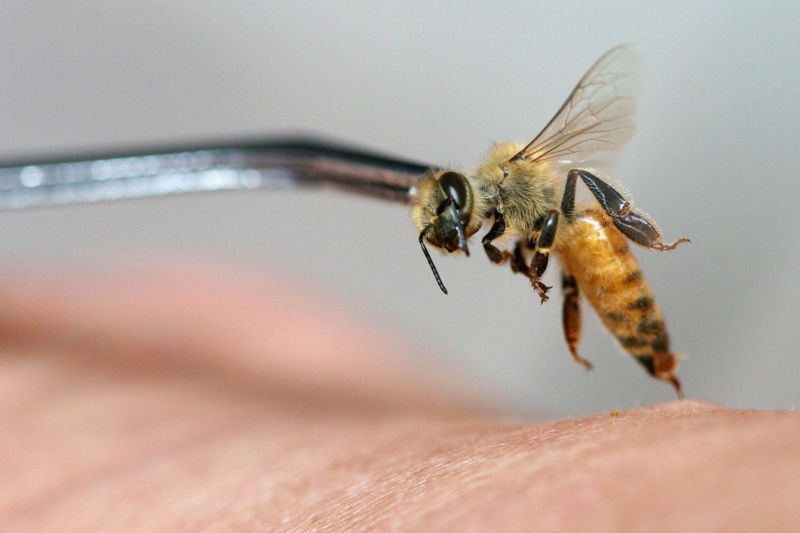
A 55-year-old Spanish woman has died following repeated exposures to an acupuncture method that uses live, stinging bees instead of traditional needles, according to a recent case report in the Journal of Investigational Allergology and Clinical Immunology.
The painful and dangerous practice—called apipuncture—is generally peddled by nonmedical practitioners and, in recent years, has generated buzz among celebrities, most notably Gwyneth Paltrow and her chic lifestyle brand Goop. Paltrow and other proponents claim that insect venom can relieve a swarm of ailments, including inflammation, arthritis, generalized pain, scarring, and skin issues.But evidence to back those claims is weak and mixed, and numerous medical studies have tallied serious risks and adverse events, including anaphylaxis, stroke, and death. Perhaps most alarming is that people with no history of allergies to bee venom can become sensitive to it over time. In fact, the more exposure, the greater the risk of developing a sensitivity. And life-threatening reactions appear unpredictably.
That seemed to be the case for the Spanish woman. While it's unclear how she learned about the stinging apipuncture, her doctors noted in their medical report that she had attended sessions every four weeks for two years with no issues prior to her death. She had sought the bee-based treatment—a form of apitherapy—for stress and muscle tightness. But during what would be her final session, she began wheezing and lost consciousness.
Personnel at the apitherapy clinic were unprepared for the medical emergency and could only provide her with methylprednisolone, a drug that reduces inflammation. It took 30 minutes for an ambulance to arrive. By that time, her systolic blood pressure (the top number of blood pressure readings) plummeted to 42 mmHg. (A normal range is often considered to be from 90 to 119 mmHg.) Emergency medical personnel arriving on the scene promptly gave her a double dose of adrenaline, saline infusion, intravenous corticosteroids, and antihistamines.
Though her blood pressure and heart rate stabilized on the way to the hospital, doctors there determined that she had suffered a massive stroke from severe anaphylaxis (acute allergic reaction) and slipped into a permanent coma. She died several weeks later from multi-organ failure.
Pain, no gain
The doctors say that better training among the apitherapy personnel and a faster ambulance response time may have prevented her death. But, they add, such favorable conditions may not be realistic or possible for these types of clinics.
“Therefore, the risks of undergoing apitherapy may exceed the presumed benefits, leading us to conclude that this practice is both unsafe and unadvisable,” they conclude.
That squares with a 2015 literature review by South Korean researchers. They looked at 145 studies on bee-venom therapy and concluded that “adverse events related to bee-venom therapy are frequent.” They also noted the potential for bee-venom sensitivity to fly up unexpectedly, citing a 2008 report of a 21-year-old who died of anaphylaxis from an accidental bee sting one year after receiving repeated apipuncture sessions.
Last, the researchers noted that studies indicating benefits from the therapy were difficult to interpret “owing to the poor reporting quality.”
Still, all these criticisms haven’t stopped some celebrities and tabloids from continuing to champion the bee-venom treatments. For instance, Kourtney Kardashian has endorsed bee-venom skin products, and tabloids have hummed over reports that Kate Middleton, Victoria Beckham, and others use bee-venom facials and other products.But Gwyneth Paltrow is likely the most high-profile proponent. In a 2016 piece for The New York Times, Paltrow noted that she’d “been stung by bees.”
“It’s a thousands-of-years-old treatment called apitherapy. People use it to get rid of inflammation and scarring. It’s actually pretty incredible if you research it. But, man, it’s painful,” she wrote.
On her lifestyle e-commerce site, Goop, she personally endorses bee-venom products, bee-sting therapy, and apipuncture, claiming “I was recently given ‘bee-venom therapy’ for an old injury and it disappeared.”
Journal of Investigational Allergology and Clinical Immunology, 2018. DOI: 10.18176/jiaci.0202 (About DOIs).
reader comments
280